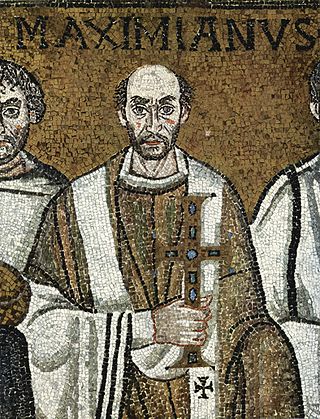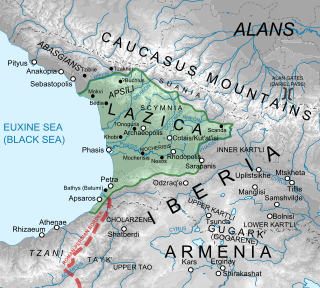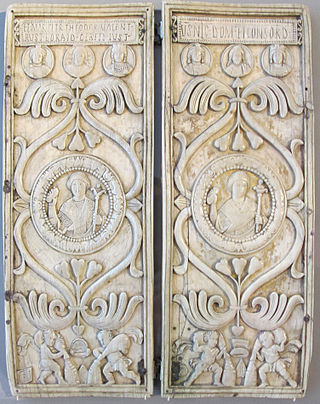Related Research Articles
The 530s decade ran from January 1, 530, to December 31, 539.
The 510s decade ran from January 1, 510, to December 31, 519.
The 540s decade ran from January 1, 540, to December 31, 549.
The 550s decade ran from January 1, 550, to December 31, 559.
The 560s decade ran from January 1, 560, to December 31, 569.
The 580s decade ran from January 1, 580, to December 31, 589.

Year 518 (DXVIII) was a common year starting on Monday of the Julian calendar. At the time, it was known as the Year of the Consulship of Paulus without colleague. The denomination 518 for this year has been used since the early medieval period, when the Anno Domini calendar era became the prevalent method in Europe for naming years.

Year 541 (DXLI) was a common year starting on Tuesday of the Julian calendar. In the Roman Empire, it was known as the Year of the Consulship of Basilius without colleague. Basilius was the last person to be officially appointed Roman consul, since after this year, the office was permanently merged with the office of Roman/Byzantine emperor. Thus, from the next year forward, the consular year dating was abandoned. The denomination 541 for this year has been used since the early medieval period, when the Anno Domini calendar era became the prevalent method in Europe for naming years.

Year 544 (DXLIV) was a leap year starting on Friday of the Julian calendar. The denomination 544 for this year has been used since the early medieval period, when the Anno Domini calendar era became the prevalent method in Europe for naming years.

Year 549 (DXLIX) was a common year starting on Friday of the Julian calendar. The denomination 549 for this year has been used since the early medieval period, when the Anno Domini calendar era became the prevalent method in Europe for naming years.

Year 556 (DLVI) was a leap year starting on Saturday of the Julian calendar. The denomination 556 for this year has been used since the early medieval period, when the Anno Domini calendar era became the prevalent method in Europe for naming years.

The Lazic War, also known as the Colchidian War or in Georgian historiography as the Great War of Egrisi, was fought between the Byzantine Empire and the Sasanian Empire for control of the ancient Georgian region of Lazica. The Lazic War lasted for twenty years, from 541 to 562, and ended with the Fifty-Year Peace Treaty, which obligated the Byzantine Empire to pay tribute to Persia each year for the recognition of Lazica as a Byzantine vassal state by Persians. The Lazic War is narrated in detail in the works of Procopius and Agathias.

Flavius Mar. Petrus Theodorus Valentinus Rusticius Boraides Germanus Iustinus, simply and commonly known as Justin, was an Eastern Roman aristocrat and general. A member of the Justinian Dynasty and nephew of Emperor Justinian I, he was appointed as one of the last Roman consuls in 540, before going on to assume senior military commands in the Balkans and in Lazica. He fought against the Slavs, the Sassanid Persians and supervised the Byzantine Empire's first contacts with the Avars. At the time of Justinian's death, he was seen as a probable successor, but was beaten to the throne by his cousin, Justin II, who exiled him to Egypt, where he was murdered.
Gubazes II was king of Lazica from circa 541 until his assassination in 555. He was one of the central personalities of the Lazic War (541–562). He originally ascended the throne as a vassal of the Byzantine Empire, but the heavy-handed actions of the Byzantine authorities led him to seek the assistance of Byzantium's main rival, Sassanid Persia. The Byzantines were evicted from Lazica with the aid of a Persian army in 541, but the Persian occupation of the country turned out to be worse, and by 548, Gubazes was requesting assistance from Byzantium. Gubazes remained a Byzantine ally during the next few years, as the two empires fought for control of Lazica, with the fortress of Petra as the focal point of the struggle. Gubazes eventually quarrelled with the Byzantine generals over the fruitless continuation of the war, and was assassinated by them.
Tzath II was King of Lazica as a Byzantine client from 556 to an unknown date.
Tzath I, Tzathius or Tzathios in Byzantine sources, was king of Lazica from 521/522 to an unknown date. He rejected Sassanid Persian overlordship and turned to the Byzantine emperor Justin I for aid. He was the first Christian king of Lazica.

Opsites is the name twice mentioned by the 6th-century AD Eastern Roman historian Procopius in his De Bellis, while recounting the events related to the Lazic War (541–562) fought between the Eastern Roman and Sassanid Persian empires over the Caucasian state of Lazica.

Damnazes was a 6th-century king of Lazica, a contemporary of the Sassanid king of Iran Kavadh I. Damnazes, like other kings of Late Antique Lazica, is mentioned by the contemporary chronicles in the context of the rivalry between the Eastern Roman (Byzantine) Empire and Sassanid Iran in the Caucasus.
Bessas was an Eastern Roman general of Gothic origin from Thrace, primarily known for his career in the wars of Justinian I. He distinguished himself against the Sassanid Persians in the Iberian War and under the command of Belisarius in the Gothic War, but after Belisarius' departure from Italy he failed to confront the resurgent Goths and was largely responsible for the loss of Rome in 546. Returning east in disgrace, despite his advanced age he was appointed as commander in the Lazic War. There he redeemed himself with the recapture of Petra, but his subsequent idleness led Justinian to dismiss him and exile him to Abasgia.
Fariburz, known in Byzantine sources as Phabrizus, was a 6th-century Iranian military officer from the Mihran family, who served under the Sasanian king Khosrau I.
References
- ↑ Robertson, A. H. F.; Parlak, Osman; Ünlügenç, Ulvi Can (2013). Geological Development of Anatolia and the Easternmost Mediterranean Region. Geological Society of London. p. 461. ISBN 9781862393530.
- 1 2 Ralph Alan Griffiths (June 29, 2004). The Gwent County History: Gwent in prehistory and early history. University of Wales Press. ISBN 978-0-7083-1826-3.
- ↑ Martindale, Jones & Morris 1992 , pp. 560, 841, 1103–1104; Bury 1958 , p. 118; Greatrex & Lieu 2002 , pp. 120–121
- ↑ Ancient and Early Medieval Chinese Literature (vol.3 & 4): A Reference Guide, Part Three & Four. BRILL. September 22, 2014. pp. 1541–. ISBN 978-90-04-27185-2.
- ↑ John Insley Coddington; American Society of Genealogists; Association for the Promotion of Scholarship in Genealogy (1980). A Tribute to John Insley Coddington on the occasion of the fortieth anniversary of the American Society of Genealogists. Association for the Promotion of Scholarship in Genealogy.
- ↑ Trish Clark (2010). France, United Kingdom, Ireland. HiddenSpring. pp. 215–. ISBN 978-1-58768-057-1.
- ↑ Hồng Đức Trần; Anh Thư Hà (2000). A Brief Chronology of Vietnam's History. Thế Giới Publishers.
- ↑ Parke Godwin (1860). The History of France: (Ancient Gaul). Harper & brothers. pp. 350–.
- ↑ Ancient and Early Medieval Chinese Literature (vol.3 & 4): A Reference Guide, Part Three & Four. BRILL. September 22, 2014. pp. 1697–. ISBN 978-90-04-27185-2.